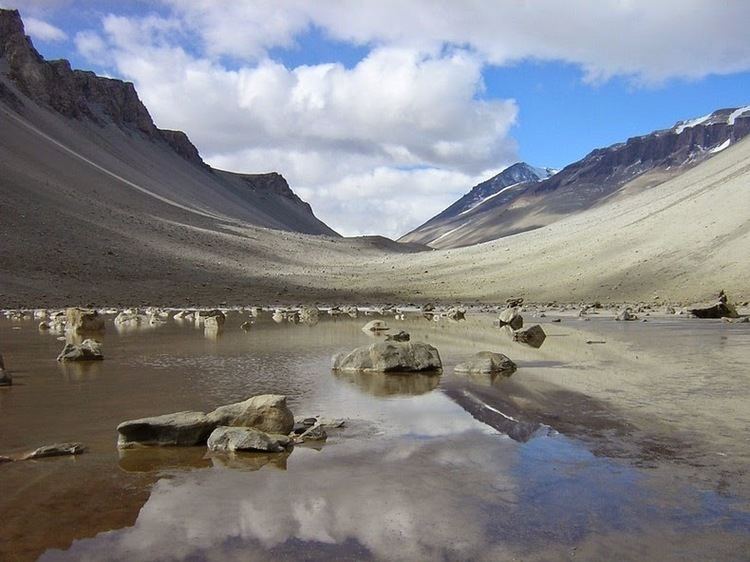Basin countries (Antarctica) Max. width 100 m (330 ft) Area 3 ha Volume 0.000003 km³ | Max. length 300 m (980 ft) Surface area 0.03 km (0.012 sq mi) Length 300 m Width 100 m | |
 | ||
Similar Guaíra Falls, Lake Assal, Meteor Crater, Vanda Station, Dune of Pilat | ||
Don Juan Pond, also called Don Juan, is a small and very shallow hypersaline lake in the west end of Wright Valley (South Fork), Victoria Land, Antarctica, 9 kilometres (5.6 mi) west from Lake Vanda. It is wedged between the Asgard Range to the south and the Dais Range to the north. On the west end is a small tributary and a rock glacier. With a salinity level of over 40%, Don Juan Pond is the saltiest known body of water on Earth.
Contents
Map of Don Juan Pond, Antarctica
Don Juan Pond was discovered in 1961. It was named for two helicopter pilots, Lt. Don Roe and Lt. John Hickey, who piloted the helicopter involved with the first field party investigating the pond. On that initial investigation, the temperature was −30 °C (−22 °F) and the water remained in a liquid state.
Salinity
Don Juan Pond is a shallow, flat-bottom, hyper-saline pond. It has greater salinity than the Dead Sea or even Lake Assal (Djibouti) (the same is true for Lake Vanda and perhaps other lakes in the McMurdo Dry Valleys). It is claimed that Don Juan Pond is over 18 times the ocean's salinity and 1.3 times that of the Dead Sea. The fact that it is the only one of the Antarctic hypersaline lakes that almost never freezes is an indication of its top rank in salinity among the world's lakes. It has been described as a groundwater discharge zone. The dominant ions in solution are calcium and chloride. The area around Don Juan Pond is covered with sodium chloride and calcium chloride salts that have been precipitated as the water evaporated. Area and volume of Don Juan Pond vary over time. According to the USGS topographical map published in 1977, the area was approximately 0.25 km2 (62 acres). However, in recent years the pond has shrunk considerably. The maximum depth in 1993–1994 was described as "a foot deep" (30 cm). In January 1997, it was approximately 10 centimetres (3.9 in) deep; in December 1998 the pond was almost dry everywhere except for an area of a few tens of square meters. Most of the remaining water was in depressions around large boulders in the pond.
The calculated composition for its water is CaCl2 3.72 mol/kg and NaCl 0.50 mol/kg, at the temperature of -51.8 °C. That would be equivalent to 413 g of CaCl2 and 29 g of NaCl per kg of water (i.e. 44.2 percent salinity by weight).
Life
Studies of lifeforms in the hypersaline (and/or brine) water of Don Juan Pond have been controversial.
